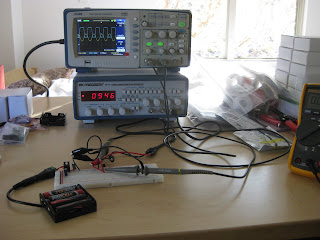It occurred to me that I have to be incredibly careful with regards to 120/240AC power sources. While I am coming with lots of battery packs, solar panels, USB-powered sources -- these are all single-side DC sources. For the later experiments in 6.002x, such as those that deal with the use of opamps, we need to provide +/-15V supplies which cannot be as conveniently generated from "portable" power sources.
Additionally, it struck me that if any of the fuses blow, or the measurement apparatus is somehow incompatible with 240Vac, then this project can be held back. So, getting the things powered up correctly in Mongolia is a potential Achilles' heel.
For that reason, I'm going to "stress test" the instruments while I am still in the US, so that I can run down to a local Fry's store to buy replacement parts if things were to go wrong.
To begin, I got a 120/240 up/down transformer that I can use right now to simulate 240Vac (and also use to generate 120Vac in Mongolia):

First up is the oscilloscope. Check:
Next up is the function generator. Here, I exchanged the fuses according to the manufacturer's recommendation for 240Vac. I also bought lots of replacement fuses just in case:
Both the oscilloscope and the function generator work with 240Vac. Check:
That small bag of cables cost us $100. Ouch...
Now, the unfortunate items.
Here is a powered breadboard that I intend to bring. I've had this guy for several years for personal use. This box does NOT like 240Vac. In Mongolia, he MUST be powered by the step-down transformer. I checked that both +15V and -15V lines are able to source a 300-ohm resistor.
Now, I felt somewhat insecure bringing just one +/-15V source. So I obtained a bench +/-15V kit. Unfortunately, it also operates only on the 120Vac line.
Sanity check. Do things generally fit? I could benefit from another box once I wrap things more carefully...

























































